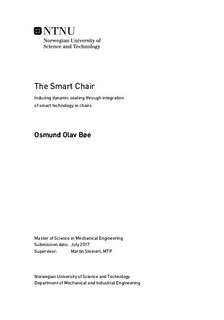The Smart Chair - Inducing dynamic seating through integration of smart technology in chairs
Master thesis
Permanent lenke
http://hdl.handle.net/11250/2456874Utgivelsesdato
2017Metadata
Vis full innførselSamlinger
Sammendrag
The world is becoming increasingly sedentary. Many jobs centered around physical work are being automated, and the time spent physically active is sinking. Various CPM (Continuous Passive Motion) chairs, and other chairs designed for increasing the activity-while-seated level have been made, and research on them are somewhat conflicted, with a majority not finding a statistically significant difference in the in the level of activity while seated (L. L. van Deursen et al. 1999; O Sullivan, O Sullivan, O Keeffe, et al. 2013; O Sullivan, O Keeffe, et al. 2012; Aota et al. 2007; Groenesteijn et al. 2012).Building on the previous work done the project thesis (appendix D) , and in TMM4245 The Fuzzy Front end 2016, two prototypes have been built capable of classifying sitting postures, estimating activity levels and altering tilt resistance. This thesis documents the building of the two prototype chairs, designed to test the effect of automated tilt resistance on a user s level of activity while seated. One chair is built to be immediate, and the tilt resistance alter the neutral angle of the chair, the other with a subtler change. A small pilot test was performed ensuring that the prototypes were working as intended, but the limited testing did not yield enough data to determine the effects either prototype could have on seating behavior. Further field tests are strongly recommended. It is also recommended to implement a reinforcement learning algorithm to the tilt resistance setting. The result could be very interesting both commercially, and with regards to research on human computer interaction.
